|
WESTERN UNION
Length 96.0 ft. Breadth 23.5 ft. Depth 9.1 ft. Gross
tonnage 91
Built in 1939. Twin screw. Diesel engine and sail
giving maximum speed of 8.5 knots.
The Western Union was in regular service for
a number of years repairing the southern group of cables. In 1956 she
was fitted with new cable hauling equipment designed jointly by Western
Union and the Telcon (see article below).
A single cable drum, 4 ft 6 in. diameter and 12 in.
between flanges, was driven by a 16 hp electric motor through a double
reduction worm gear. Ward Leonard control was provided, and the prime
mover for generator and exciter was a Ford Zephyr industrial type engine
located in the engine room. The complete equipment was capable of hauling
5 tons at ¼ knot, or 1¼ tons at 1 knot.
The ship was fitted with twin bow sheaves on a boom
protruding over the port bow, and stowage for 1000 cubic feet of cable.
The ship was not owned by Western Union, but was chartered
from Thompson Enterprises of Key West. She was based at Key West until
sold out of the cable world on 16 April 1974.
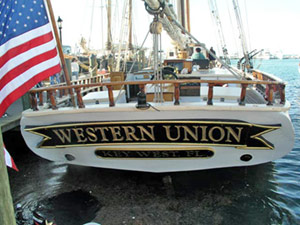 |
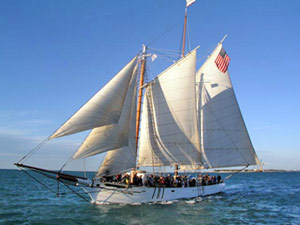 |
The Western Union
in 2004
Photos © 2004 by Tom Perera |
Status updates on CS Western Union, 2004-2021
2004: Tom Perera reports: The Western Union is now
a popular tourist attraction taking people out for day and evening sails
and star familiarization night sails. It is rather exciting to go for
a sail on this historic ship. During the pre-sail briefing, the captain
brings out sections of cable that were laid by the ship.
Read about Tom's diving
expeditions to recover early submarine telegraph cables.
2007: The Western Union is no longer in service, but is owned by the Schooner Western Union
Preservation Society in Key West, which intends to restore the ship and keep her at Key West.
July 2008: The Western Union is once more sailing out of Key West. More information on the Preservation Society's weblog and the Schooner Western Union website [dead link, archive copy].
January 2010: The Western Union is again under restoration; some information appears in a letter on the keynews.com website, but there is nothing elsewhere on line. The restoration is being directed by master shipwright Leon Poindexter; the work in progress can be seen in my photographs taken at the dry dock at the Truman Waterfront in Key West:

The Western Union under restoration at Key West, January 2010 |
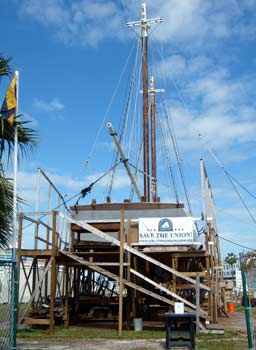
|
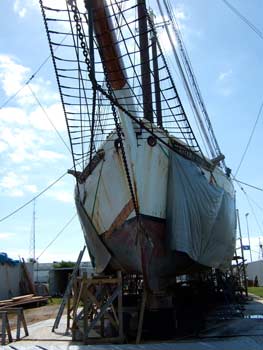
|
| Western Union in dry dock |
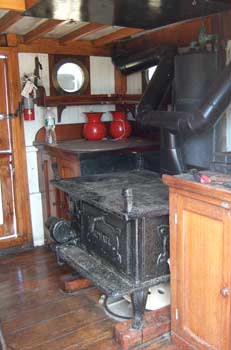
Western Union's galley |
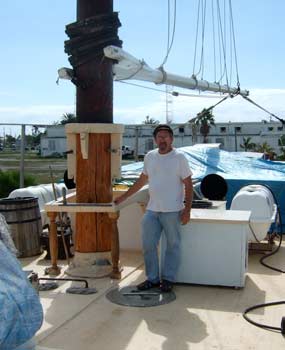
Master shipwright Leon Poindexter |
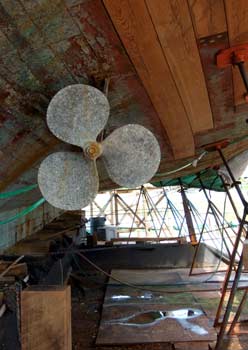
One of the twin screws,
and repairs to the hull |
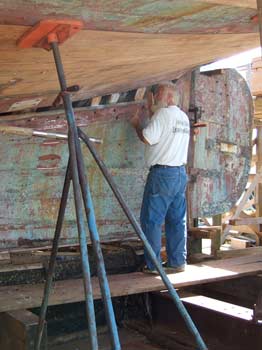
Fitting new planks at
the port-side stern |
July 2010: According to a news video at Conch TV, the Western Union has been re-launched. Further information may be found in this June 2011 story at KeysWeekly.com
January 2012: Tom Perera sends these photos of Western Union cruising off Key West:
February 2012: The Key West Chronicle blog reports that the Florida Senate passed a bill designating CS Western Union as the official flagship of the State of Florida, and it is now up to the House to do the same.
August 2014: After a failed Coast Guard inspection, repairs began again on the Western Union (story at Wooden Boat website).
February 2017: The ship is now undergoing yet another refit in Tarpon Springs on the west coast of Florida. The Schooner Western Union Facebook page has current information.
June 2021: The ship is still laid up, and there is insufficient funding to complete the restoration. The Facebook page has not been updated since February 2020.
As noted above, Telcon fitted new cable gear to the Western Union in 1956. The company's house magazine had this story on the project:
CABLE GEAR FOR THE SCHOONER "WESTERN UNION"
In 1954 a hauling gear was designed and built by Telcon for use by the Western Union Telegraph Company in their cable depot at Halifax, Nova Scotia.
Following their acceptance of that machine, they invited us to provide another, essentially similar, as a picking up and paying out gear for their cable-laying schooner "Western Union” which is stationed at Key West, Florida, and for use on cables in the shallow waters off the Florida coast and in the West Indies. This called for very careful design owing to the weight restriction and the very limited space as available The layout is as follows:—
The power unit, situated in the engine room, consists of a Crompton Parkinson Exciter mounted immediately over the generator and connected to it through a vee belt drive. The generator and exciter are driven by a Ford Zephyr Industrial Type engine developing 31 BHP with the governor set for 1900 RPM.
Power from the generator is fed through an Allen West Main Type contact, or control panel, which is totally enclosed in a sheet steel case of drip proof construction also mounted in the engine room. This panel gives Ward-Leonard control to the Crompton Parkinson D.C. 16 h.p. main motor fitted to the main hauling gear on the ship's deck.
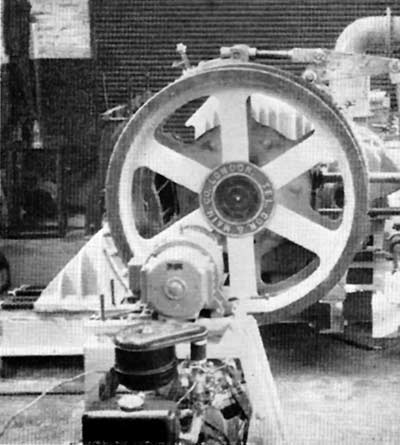
The cable drum |
The cable drum, 4 ft. 6 in. in diameter and 12 in. between flanges, is driven by the 16 h.p. electric motor through a double reduction worm gear unit having a ratio of 280/1. The motor is forced-draught ventilated by means of a self-contained, electrically driven air blower unit fitted to the air inlet, suitable inlet and exhaust ducting being provided. The speed range of the main motor is 0/500 R.P.M. by generator voltage control against constant torque and 500/2000 by air motor shunt field regulation against constant horse power. A combined slipping and holding water-cooled brake is fitted to the drum and is controlled by a screwdown mechanism.
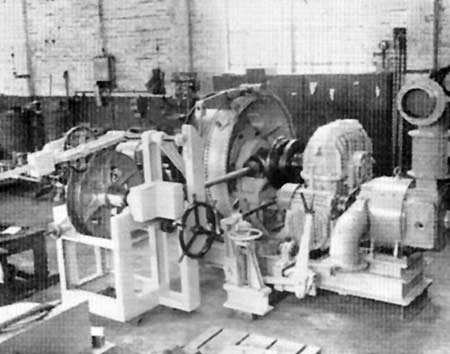
General view of the cable gear |
Push button switches for "Forward", "Reverse", "Accelerate", "Retard" and "Stop" are grouped within easy reach of the operator of the hauling gear. The main motor is capable of holding a load of up to 5 tons stalled for a period of 5 minutes without overheating, and an alarm bell rings automatically to ensure that this period is not exceeded.
A dog clutch is provided between the main drive and the cable drum and a fleeting knife assembly is fitted on the forward side of the drum. The draw-off gear is fitted with. a jockey arm and length indicator and four jockey wheels for varying sizes of cable are supplied. This draw-off gear is driven by bevel gears from the main reduction unit and a hand wheel is fitted for raising and lowering the jockey arm.
The acceptance tests were carried out on February 25 in the presence of Mr. R. A. Goodman. European Plant Engineer of the Western Union Telegraph Company and his staff. The gear was mounted on a temporary concrete test bed on the main wharf at Telcon Works, Greenwich. A j mile length of cable Type A 3-14/0 was used in conjunction with a Duckham ring gauge to indicate cable tension and three Telcon lorries provided the tractive effort when testing the braking capacity of the gear and also retardation when testing its hauling capacity.
The following tests were carried out to the satisfaction of the Western Union Telegraph Company
(a) Hauling at a quarter knot against a tension of 5 tons.
(b) Hauling at 1 knot against a tension of 11: tons.
(e) Holding stationary against a tension of 5 tons for 5 minutes with the motor stalled and brakes off.
(d) Holding against a tension of 5 tons with the brakes applied and the motor disconnected at the clutch.
(e) Paying out at a tension of 3 tons at 2 knots with brakes applied and with motor disconnected at the clutch.
Thanks to Jim Jones for supplying this article. |

